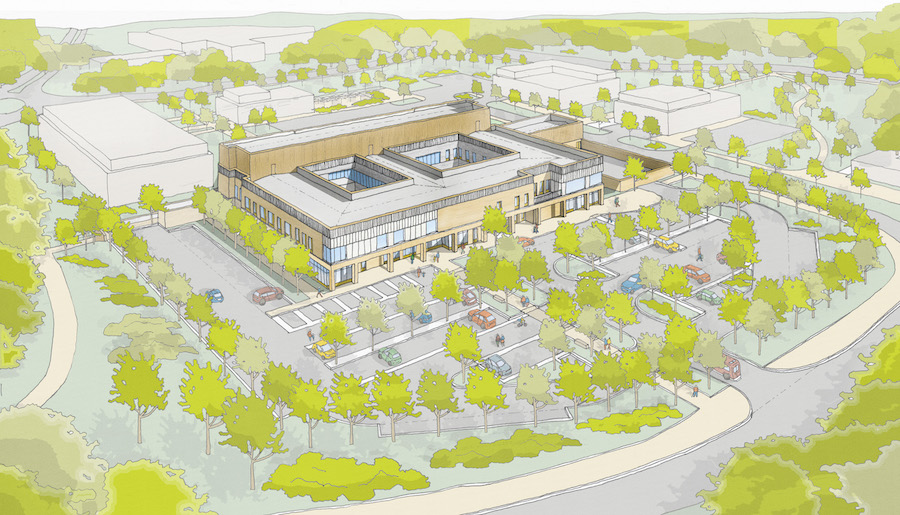Primary & community care / Sustainability
Active travel, nature and sustainability the bedrock of community hospital plans
By Andrew Sansom | 15 Mar 2023 | 0
Promoting health and wellbeing through sustainable transport, access to nature, and biophilic design is central to proposals for a new community hospital in Consett, County Durham, which have now been unanimously approved by Durham’s strategic planning committee.
Part of the New Hospital Programme’s ‘Cohort 2’, the Shotley Bridge Community Hospital project, for County Durham and Darlington NHS Foundation Trust, employs a holistic approach to health and wellbeing, providing opportunities for patients and staff to connect with the outdoors and benefit from the therapeutic qualities of nature.
Designed by Medical Architecture, the hospital is located on the edge of Consett, with easy access to the County Durham countryside. It will offer a range of facilities, including outpatient services and diagnostics, an urgent care centre, a medical investigations unit for cancer services alongside a chemotherapy day unit, family health services, and a 16-bed rehabilitation inpatient ward.
The site masterplan and hospital building have been designed to create a new pedestrian and cycle link, which connects with the Coast to Coast cycle route that runs adjacent to the site, and a new footpath leading from the town centre.
A primary entrance at the front of the building provides access to the inpatient ward and outpatient departments. On the opposite side, a pedestrian entrance connects directly with the new proposed footpath. These are connected by a central public concourse through the building, with a public cafe and clear wayfinding to all facilities. 
Connections to nature and civic presence
Arranged around a pair of courtyards, the plan allows natural daylight to penetrate deep into the heart of the building, while all occupied rooms offer an outside view. The courtyard spaces, with landscape design by ONE Environments, feature planting described as rich in texture, form and colour. The ‘Serenity Garden’ is accessible to visitors, patients and staff, and features a mixture of open and semi-private seating spaces. The ‘Healing Garden’ has been developed with clinical staff as a private, therapeutic space to assist rehabilitation.
Internally, biophilic design principles provide connections to nature, to create a non-institutional healthcare environment. Not only does this benefit patients but it also promotes wellbeing in the workplace and supports a positive culture of care.
Sitting at the entrance of a wider site masterplan envisioned as a parkland, the idea of a ‘pavilion in the park’ was a key design concept for the new hospital, which adds to its civic presence. This is also reflected in the human-scale building form, careful composition of a simple material palette, and a landscaping strategy that promotes biophilic interactions and is in keeping with the site’s context.
Historically, County Durham is known for using sandstone for important civic buildings. To draw on this, the predominant external cladding material is described as a textured, ‘multi’ light buff brick, which has similar visual qualities to the local sandstone architecture. Bandings of profiled glass-reinforced concrete panels are also introduced to emulate the texture and solidity of stone in a crafted form. And, to pay homage to the historic significance of the site as part of the former Consett Steelworks, an undulating, perforated metal rainscreen is proposed as a crown to the top storey of the building,
Sustainability, adaptability, repeatability
The hospital has been designed to achieve BREEAM Excellent status and adopts the NHS’s Net Zero Carbon standards as a guiding principle. Flexibility and adaptability have also been considered to ensure the hospital can accommodate changing models of care and service delivery. A focus on standardisation and repeatability is also evident, both to support future adaptability in the building layout and to optimise efficiencies.
 Working alongside Akerlof, a consultant in modern methods of construction, the design team has adopted a framework that includes design for manufacture and assembly, and the use of prefabricated systems and offsite manufactured components.
Working alongside Akerlof, a consultant in modern methods of construction, the design team has adopted a framework that includes design for manufacture and assembly, and the use of prefabricated systems and offsite manufactured components.
Medical Architecture director Lianne Knotts said: “We’ve designed a building that is welcoming to all and that creates an environment for care that promotes wellbeing and recovery. We’re now looking forward to making the plans a reality.”
Hanna Hardy, acquisitions lead for NHS Property Services, welcomed the planning approval, which followed “a significant amount of work and positive engagement from all involved stakeholders, including Project Genesis, technical and planning advisors DPP, Medical Architecture, and Tilbury Douglas”.
Paul Ellenor, regional director for building contractor Tilbury Douglas, added: “Our team and the project’s design partners have worked hard to develop a scheme that will benefit the local community, providing an enhanced environment for both patients and staff.”
Other members of the project team include M&E engineer A.E. Robb & Associates, and structure and civil engineer Jasper Kerr.


